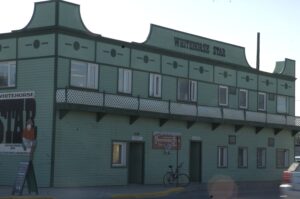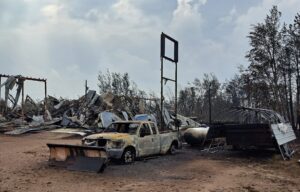The governance of Canada’s Arctic is an important factor to understanding the many dynamics at play in the region. There is a clear constitutional divide between the provinces and territories, with the territories historically being governed by federal officials. This has gradually changed over the past 40 years as federal statutes have established legislative assemblies and executive councils for each territory. Furthermore, the last several decades have seen the gradual devolution of power from Ottawa to the territories, with the result being that they now have policy mandates and responsibilities similar to the provinces. This process is currently the most advanced in Yukon, which in 2003 became the first territory to take over land and resource management responsibilities from the federal government; the Northwest Territories signed its devolution agreement with Ottawa in 2013, and Nunavut followed suit in January 2024. Of note, the Northwest Territories, Nunavut and Nunatsiavut practice consensus government—a form of consensus democracy where the legislature is entirely composed of independents who select the premier and cabinet members from amongst themselves.
Some Indigenous land claim agreements have also culminated in the creation of various forms of Indigenous self-government: for example, the 1993 Nunavut Land Claims Agreement, which is also the largest Indigenous land claims agreement in Canadian history, created the Territory of Nunavut out of what was previously part of the Northwest Territories in 1999. For political as well as historical reasons, devolution has represented an important and positive change for the territories and Indigenous peoples alike, but the reality is frequently much more complicated: with new political organizations struggling with limited administrative, financial, legal, and technical resources needed for effective self-governance in the context of a highly interdependent global economy, many throughout the country have found it difficult to resist pressures from powerful resource companies. Also, as the experience of the Inuvialuit shows, attaining self-government is a lengthy and arduous process. Although the 1984 Inuvialuit Final Agreement was the first modern comprehensive land agreement to be signed in Canada, it wasn’t until 1995 that Inuvialuit could begin self-government negotiations with Ottawa, because until then, the inherent right of Indigenous peoples to self-govern was not yet recognized in Canada. Currently, Inuvialuit still do not have self-government, although a major milestone was reached in 2015 when the Inuvialuit Regional Corporation and the governments of Canada and the Northwest Territories signed the Self-Government Agreement-in-Principle, which now forms the basis of present ongoing negotiations for a Final Agreement.
Canada is also actively involved in Arctic governance at the international level, signaling a deepening commitment to the region in 1994 with its designation of an Ambassador for Circumpolar Affairs. Being a strong supporter of Inuit efforts to deepen international Indigenous cooperation in the 1980s and 1990s meant that it played an instrumental role in the founding of the Arctic Council, taking on the inaugural chairmanship during which it led the development of the Council’s structure and working procedures. Canada finished its second chairmanship in 2015 during which it promoted economic development and founded the Arctic Economic Council. Echoing the other Arctic countries, and despite strong rhetoric in the wake of the Ukraine crisis, Canada’s Arctic policies have continued to emphasize cooperation in the region, although claiming budgetary reasons, Ottawa cut the circumpolar ambassadorship in 2006. Canada’s legal interpretation of the Northwest Passage as internal waters rather than an international strait is also a decades-old point of friction between it and its southern neighbor. Although this tension has found more or less equilibrium in the form of a more or less friendly stalemate, unless Canada is able to reliably demonstrate its sovereignty in the vast and remote waterway, the continued uptick in ships plying its less-icy but still dangerous waters could potentially shift the balance. While there also remains a dispute between the two countries in the Beaufort Sea, in June of 2022, Canada and its other neighbor, Greenland (Denmark), signed an agreement to settle a half-century-old dispute over the nationality of Hans Island/Tartupaluk, creating a land border between the two countries and putting a final end to the ‘Whisky War.’
In May 2019, Canada submitted to the UN Commission on the Limits of the Continental Shelf (CLCS) its long-awaited partial submission concerning its continental shelf in the Arctic Ocean. Now overlapping with the earlier submissions of Denmark and Russia at the Lomonosov Ridge and the symbolic North Pole, at the same time, Canada stressed its regular consultations with them, as well as with the US, throughout the preparation period of over a decade. With the CLCS review process being lengthy, as well as in light of the fact that the boundaries will ultimately be negotiated by the countries themselves, the international cooperative enterprise of determining the legal limits of the continental shelves in the Arctic Ocean is far from over.
Canada is party to the Arctic Search and Rescue Agreement and the Agreement on Cooperation on Marine Oil Pollution, Preparedness and Response in the Arctic, both negotiated under the auspices of the Arctic Council. An ‘Arctic five’ country, Canada joined Denmark, Norway, Russia, and the United States in signing the 2015 Declaration Concerning the Prevention of Unregulated High Seas Fishing in the Central Arctic Ocean. In 2018, the Arctic five, plus China, the EU, Iceland, Korea, and Japan, signed the Agreement to Prevent Unregulated High Seas Fisheries in the Central Arctic Ocean, which went into force in June 2021.
After the hawkish tone of Canada’s Arctic policy under nearly a decade of Conservative leadership by former Prime Minister Stephen Harper, the Liberal government of Prime Minister Justin Trudeau, which came to power in 2015, has in some respects shifted its approach to its North. While in some ways, the Trudeau government’s priorities in the Arctic haven’t changed all that much from its predecessor’s, its shift towards co-governance with Indigenous nations from devolution does represent a departure. 2017 saw the creation of the Inuit-Crown Partnership Committee, a permanent organization with a mandate to advance interests shared between Inuit and the Canadian state; in 2023, the landmark Western Arctic—Tariuq (Offshore) Accord was signed between the Inuvialuit Regional Corporation, NWT, Yukon, and the Canadian Federal government, making it the first of its kind to have an Indigenous government as full party to decision making on natural resources; and, emphasizing that policy development is being undertaken “with” northerners rather than “for” them, Canada is also currently giving its Arctic policy an overhaul to replace the nearly decade-old one. However, it remains to be seen how—and to what extent—political will translates ideas to real benefits for northerners, especially Indigenous peoples.
However, with a rapidly changing environment bringing more human activity—especially tourism—to its massive and remote north, security remains firmly on the radar for Canada, too, with an accent on high-tech intelligence. While the first Arctic patrol ship, the HMCS Harry DeWolf, finally took its first voyage in 2021, a much-needed new polar-class icebreaker, the CCGS John G. Diefenbaker, remains under construction after lengthy delays; meanwhile, advanced technologies such as satellite geoimaging and UAVs present opportunities for the Department of National Defence to increase surveillance capacities in Canada’s challenging and remote Arctic geography. Filling in the gaps in what Canada knows is happening in its Arctic territories, this would, among other things, facilitate search and rescue capabilities—an evergreen concern for the Arctic Council—but also help Canada keep tabs on naval traffic.


